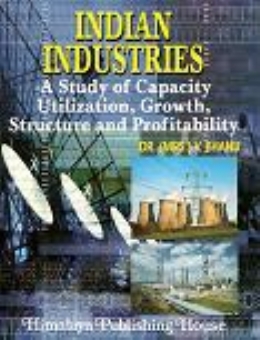The study examines the long-term trends in industrial capacity utilisation, growth and structure at the aggregate and at the disaggregate levels, broadly for the period 1980 -2000. The study also measures profitability in the select firms of Indian corporate sector and analyses the relationships between size, profitability and growth during 1990-1 to 1997-8. In other words the study proposes to empirically examine the impact of reforms on the above issues. The study presents a detailed discussion of the concept of capacity, measures of capacity utilisation, methodology adopted, sources of data and the review of literature. Three distinct methods viz., Wharton, Modified Wharton and RBI Potential Utilisation have been used to analyse capacity utilisation in sixteen two digit and thirty- three four digit industries (29.75 per cent of total manufacturing sector) for the period 1980/81 – 2000. All the above methods are based on monthly output data. The Monthly Abstract of Statistics and the Index of Industrial Production – the Central Statistical Organisation publications (CSO), are the sources of data. Capacity utilisation is analysed even for use-based classification of the above-mentioned industries. For the purpose of analysis, the period of study is further classified into four sub-periods viz., 1980/81-1985, 1986-1990, 1991-1995 and 1996-2000. Industrial growth and structure are examined for seventeen two-digit and twenty-six three-digit industries, which correspond to the thirty-three select industries analysed for capacity utilisation. The study covers a period of seventeen years from 1981-82 to 1997-98. It is based on Annual Survey of Industries data, compiled by the Economic and Political Weekly Research Foundation (2002). Net fixed assets, employment and net value added are the parameters adopted to analyse growth and structure. Further, economic ratios, such as capital-output, capital-labour and output-labour ratios have been computed for the two and three-digit industries for the period of study. The analysis is at constant prices with 1981-82 as the base. The study is also an empirical verification of the profitability of 108 select companies for the period 1991- 1999. It also empirically examines the growth in the size of 134 select companies during 1990-91 to 1997-98. The 134 select companies account for about 41 per cent of sales; 32 per cent of net fixed assets, 23 per cent of paid-up capital and 7 per cent of number of companies respectively of the 1948 companies of the RBI study (1997-98). The study further explores the relationships between size and profitability; growth and profitability and size and growth in the aggregate as well as at the industry levels of the 134 select companies during 1990-91 to 1997-98. Several issues of the Official Directory of Bombay Stock Exchange constitute the source of data. The companies have been selected on the basis of availability of information for the entire period of the study and consistency in the reporting. The analysis is at current prices.
The important findings of the study are: There are cyclical variations in capacity utilisation of two-digit and the thirty-three select industries both at the aggregate and disaggregate levels. Utilisation is higher under Wharton method and lower under the RBI method. As compared to Wharton method, greater variability exists under Modified Wharton method. Utilisation was higher in the 1980s as compared to the 1990s. There is higher utilisation during the sub-period 1996 – 2000, as compared to any other sub-periods. However, basic metal and alloy, chemical and rubber of two-digit industries and cement, caustic soda, petroleum products, tea and nitrogenous fertilizer of thirty-three select industries registered consistently a higher rate of utilisation during the period of study. The growth in the manufacturing sector for the 1990s as a whole was high, but there have been definite signs of slow down in the later years. The higher ratio of capital to output and capital to employee clearly indicates the capital-intensive nature of industrial growth in India during the period of the study. Barring a few industries, spurt in growth in fixed assets is seen in both two-digit and three-digit industries. Many of the three-digit industries have absorbed a larger share of growth in employment and there is buoyancy in the growth rate of value added too. Thus, the positive effect of policy change is clearly visible. But, in the process, two major capital goods industries viz., finished steel and machine tools have lost substantially. There is a clear change in India`s industrial structure – the declining share of capital goods industries and the significant improvement in the share of intermediate and consumer goods industries are the pointers in this direction. The positive impact of reforms on the corporate sector is evident from the robust performance of this sector during 1990-1 to 1997-8. There was boom in investment and paid-up capital and sales too, as a number of companies moved from smaller size class to either medium or larger size class, though a definite slow down is seen in the later years of the study. Profitability measured in terms of margin of sales, return on capital employed, on total assets and on net-worth have been impressive in the early years of the 1990s but weakened during 1996-7 and 1997-8. The analysis of relationship between size, profitability and growth of firms showed some association for the aggregate of select companies but did not support the hypothesis in its entirety. In the industry-wise analysis, size and growth are related when growth is measured in terms of total capital employed. There is some association between growth and profitability, as profitability is invariably higher for largest size-class.
Contents :
Preface
Acknowledgment
List of Tables
List of Diagram
List of Appendices
Chapter I INTRODUCTION
Chapter II GROWTH AND STRUCTURE OF INDIAN INDUSTRIES
Chapter III CONCEPTS, MEASURES OF CAPACITY UTILIZATION
Chapter IV CAPACITY UTILIZATION IN INDIAN INDUSTRIES – AN AGGREGATE ANALYSIS
Chapter V CAPACITY UTILIZATION IN INDIAN INDUSTRIES – A DISAGGREATE ANALYSIS
Chapter VI PROFITABILITY IN THE INDIAN CORPORATE SECTOR
Chapter VII SUMMARY AND CONCLUSIONS
BIBLIOGRAPHY






